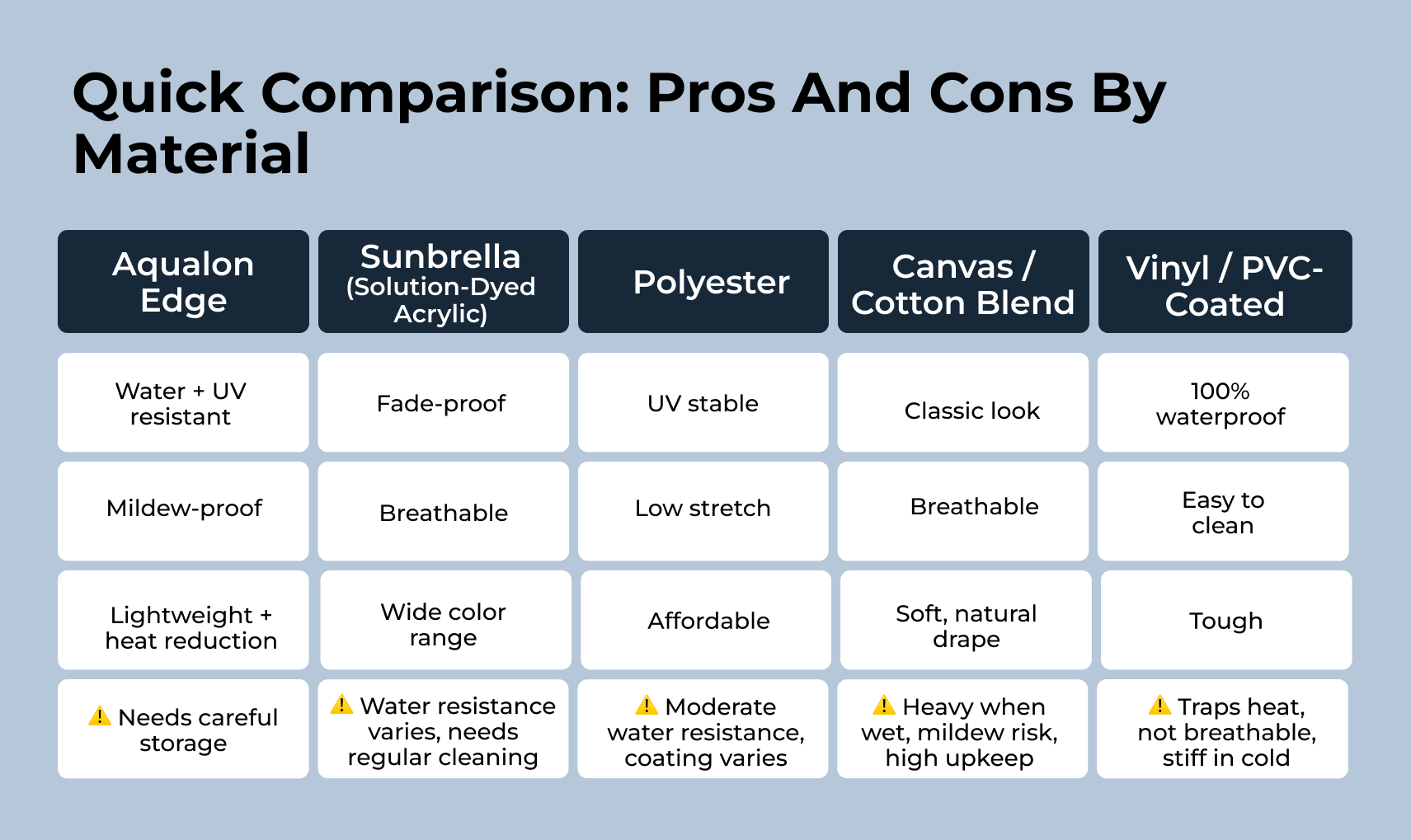Every boater knows the feeling — that small sigh of relief when you pull the cover tight and know your boat is safe. But not all covers earn that peace of mind. The secret lies in the material. From blistering UV rays to salt spray and humidity, every environment tests your cover in different ways, and the right fabric can mean the difference between years of protection or a season of frustration.
In this guide, we break down the most popular boat cover materials — from Aqualon® Edge and Sunbrella® to polyester, canvas, and vinyl — so you can understand how each performs where it counts: durability, UV resistance, water protection, breathability, and long-term value.
At Marine Concepts, we’ve seen it all — boats that weather every storm and covers that couldn’t handle a single summer. That’s why we build custom-fit covers designed around your boat, your dock, and your lifestyle.
“Best” depends on conditions, frequency of use, and the way a cover is installed and handled. The right fabric should be abrasion-resistant, water-resistant, stable under UV resistance testing, manageable for one-person operation, and matched to your slip or lift. For many owners, the winning setup is a custom-fit cover in a proven fabric that is easy to deploy and stow, which leads to better compliance and a consistently clean boat.

What it is: A modern marine composite engineered for durability, high water resistance, UV stability, and mildew resistance at a relatively low weight.
Pros
Cons
Best for: Year-round or frequent use, coastal or inland, roofed or open slips, owners who want maximum performance with minimal maintenance. Marine Concepts fabricates custom covers in Aqualon Edge and installs them with a boat cover track system tuned to your dock structure.

What it is: A solution-dyed acrylic weave renowned for colorfastness and breathability.
Pros
Cons
Best for: Boats under a roof with strong airflow, owners prioritizing color options and breathability who keep up with routine cleaning.

What it is: Woven polyester with various coatings.
Pros
Cons
Best for: Budget-conscious buyers seeking dependable protection in moderate environments.

What it is: Traditional cotton duck or blends used historically in marine covers.
Pros
Cons
Best for: Niche applications where heritage look matters and owners commit to diligent drying and maintenance.

What it is: Vinyl or PVC-coated fabrics, sometimes with polyester scrims.
Pros
Cons
Best for: Short-term mooring, rainy regions, or covers that need fast cleanup and rugged splash protection.
Boat cover materials affect how easily a cover moves. Heavier woven acrylics or thick vinyls can be durable, but they can make daily handling cumbersome. Lighter fabrics like Aqualon Edge reduce effort, making one-person operation easier and faster. Pairing a strong, lightweight fabric with a smooth track system helps avoid wrestling with snaps or fasteners, encouraging consistent use and long-term protection.
Even high-quality fabric won’t perform well if the fit is off. Wrinkles invite water pooling, loose hems cause abrasion, and gaps let insects and debris in. Digital measuring, careful patterning, and hand-sewn craftsmanship ensure the cover hugs the hull and accommodates dock obstacles. A precise fit reduces leaks, abrasion and keeps the boat cleaner every time it’s uncovered.
Materials that reflect heat effectively keep the boat interior cooler, protecting upholstery, electronics, and sensitive hardware. Comfortable interiors make it more appealing to cover the boat regularly, helping preserve the vessel’s appearance and function over time. Heat-resistant fabrics enhance both usability and long-term protection.
Consider upfront cost alongside years of service, cleaning frequency, and UV protection. Premium fabrics tend to last longer and require less maintenance, while a well-fitted cover reduces stress points that lead to wear. Track systems designed for easy installation without permanent dock modifications can further extend the cover’s lifespan and simplify care.

What is the best boat cover material for daily use on a roofed dock?
A light yet durable composite like Aqualon Edge, paired with a custom-fit pattern, performs exceptionally well. It balances water resistance, UV resistance, and easy handling, which encourages consistent use.
Do breathable fabrics prevent mildew completely?
No fabric can ignore standing moisture or organic debris. Breathable weaves help, yet regular rinsing and drying routines still matter. A clean surface plus smart vent placement provides the best outcome.
Is a heavier fabric always more durable?
Not necessarily. Modern composites achieve strong abrasion resistance at lower weights. Construction quality, seam design, and how the cover is used each day influence longevity as much as raw ounces.
What is the best thickness for a boat cover?
The best thickness for a boat cover depends on the material and how you plan to use it. Thicker fabrics like heavy vinyl or dense woven acrylic provide extra durability and protection, but can be heavier and harder to handle. Lighter yet strong materials like Aqualon Edge strike a balance—offering excellent protection while making one-person handling easier.
When you want it handled end-to-end, Marine Concepts designs, measures, fabricates, and installs custom boat covers built from premium marine fabrics, including Aqualon Edge. The patented boat cover track system makes covering your boat feel simple, which is the entire point. Reach out for a tailored recommendation that matches your boat, dock, and lifestyle.